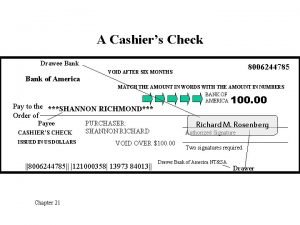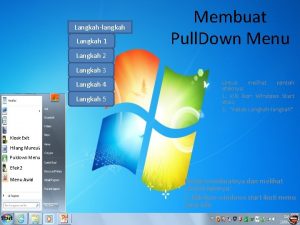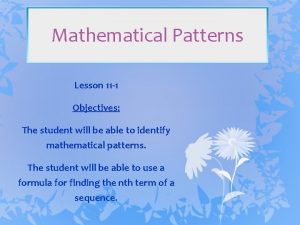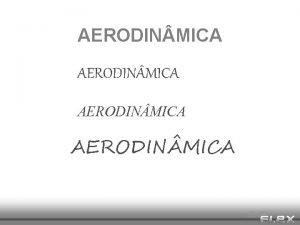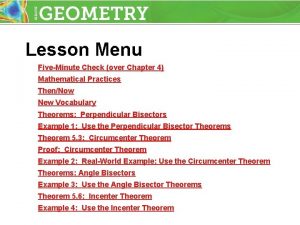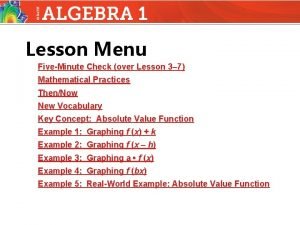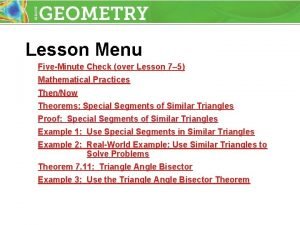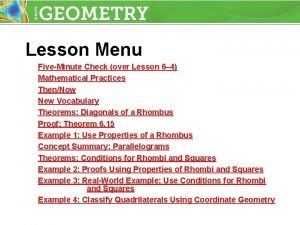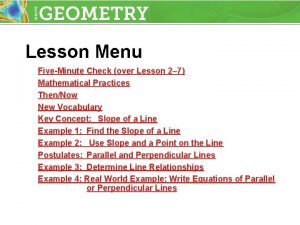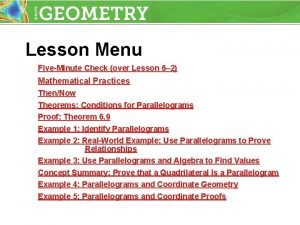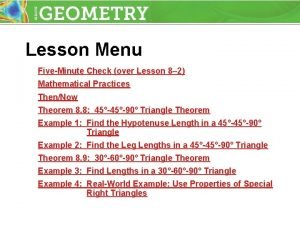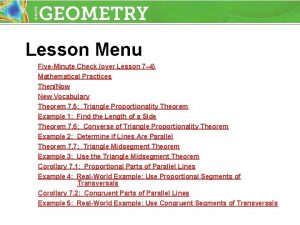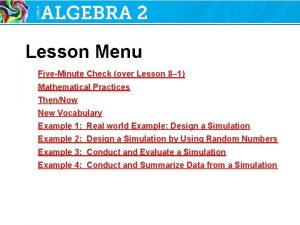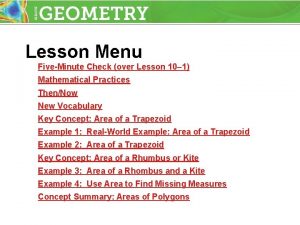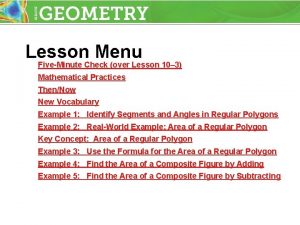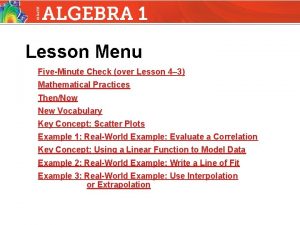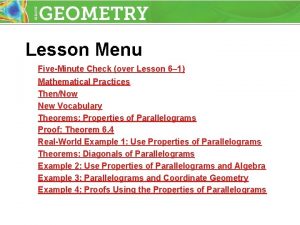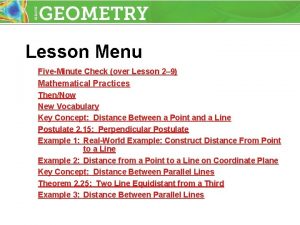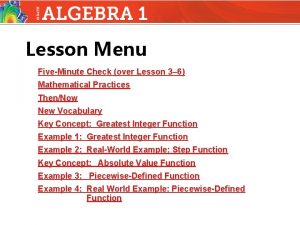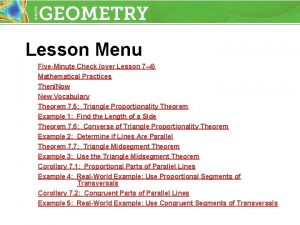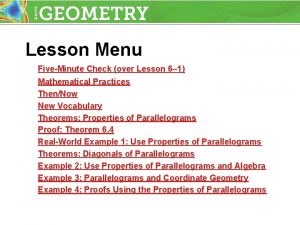Lesson Menu FiveMinute Check over Lesson 6 Mathematical


























- Slides: 26

Lesson Menu Five-Minute Check (over Lesson 6) Mathematical Practices Then/Now Key Concept: Dilation Example 1: Draw a Dilation Example 2: Real-World Example: Find the Scale of a Dilation Key Concept: Dilations in the Coordinate Plane Example 3: Dilations in the Coordinate Plane

Over Lesson 6 Complete the statement about parallelogram LMNO. ? A. B. C. D.

Over Lesson 6 Complete the statement about parallelogram LMNO. ? A. B. C. D.

Over Lesson 6 Complete the statement about parallelogram LMNO. OLM ____ ? A. MNO B. LON C. MPN D. MPL

Over Lesson 6 Complete the statement about parallelogram LMNO. ? A. B. C. D.

Over Lesson 6 Find the measure of each interior angle. A. m A = 60, m B = 120, m C = 60, m D = 120 B. m A = 65, m B = 115, m C = 65, m D = 115 C. m A = 65, m B = 115, m C = 60, m D = 120 D. m A = 70, m B = 110, m C = 70, m D = 110

Over Lesson 6 Which of the statements about an isosceles trapezoid is false? A. The diagonals are congruent. B. Two sides are both congruent and parallel. C. Two pairs of base angles are congruent. D. One pair of sides are congruent.

Mathematical Practices 1 Make sense of problems and persevere in solving them. 5 Use appropriate tools strategically. Content Standards G. CO. 2 Represent transformations in the plane using, e. g. , transparencies and geometry software; describe transformations as functions that take points in the plane as inputs and give other points as outputs. Compare transformations that preserve distance and angle to those that do not (e. g. , translation versus horizontal stretch). G. SRT. 1 Understand similarity in terms of similarity transformations. Verify experimentally the properties of dilations given by a center and a scale factor: a. A dilation takes a line not passing through the center of the dilation to a parallel line, and leaves a line passing through the center unchanged. b. The dilation of a line segment is longer or shorter in the ratio given by the scale factor.

You identified dilations and verified them as similarity transformations. • Draw dilations in the coordinate plane.


Draw a Dilation Copy trapezoid PQRS and point C. Then use a ruler to draw the image of trapezoid PQRS under a dilation with center C and scale factor 3. Since k > 1, the dilation is an enlargement of trapezoid PQRS.

Draw a Dilation Copy trapezoid PQRS and point C. Then use a ruler to draw the image of trapezoid PQRS under a dilation with center C and scale factor 3. Locate P', Q', R', and S' so that

Draw a Dilation Copy trapezoid PQRS and point C. Then use a ruler to draw the image of trapezoid PQRS under a dilation with center C and scale factor 3. Answer: Draw trapezoid P'Q'R'S'.

Which diagram shows the dilation image of ΔLMN with center C and ? A. B. C. D.

Find the Scale Factor of a Dilation PUPPETS To create the illusion of a “life-sized” image, puppeteers sometimes use a light source to show an enlarged image of a puppet projected on a screen or wall. Suppose that the distance between a light source L and the puppet is 24 inches (LP). To what distance PP' should you place the puppet from the screen to create a 49. 5 -inch tall shadow (I'M') from a 9 -inch puppet?

Find the Scale Factor of a Dilation Understand This problem involves a dilation. The center of the dilation is L, LP = 24 in. , IM = 9 in. , I'M' = 49. 5 in. You are asked to find PP'. Plan Find the scale factor of the dilation from the preimage IM to the image I'M'. Use the scale factor to find LP and then use LP and LP' to find PP'.

Find the Scale Factor of a Dilation Solve The scale factor k of the enlargement is the ratio of the length on the image to a corresponding length on the preimage. Scale factor of image = I'M', preimage = IM Divide.

Find the Scale Factor of a Dilation Use this scale factor of 5. 5 to find LP' = k(LP) Definition of dilation = 5. 5(24) k = 5. 5 and LP = 24 = 132 Multiply. Use LP' and LP to find PP'. LP + PP' = LP' Segment Addition 24 + PP' = 132 LP = 24 and LP' = 132 PP' = 108 Subtract 24 from each side.

Find the Scale Factor of a Dilation Answer: So, the puppet should be placed so that the distance from it to the screen (PP') is 108 inches. Check Since the dilation is an enlargement, the scale factor should be greater than 1. Since 5. 5 > 1, the scale factor is reasonable.

PUPPETS Suppose you have a similar situation with the puppet and light source. The distance between the light source L and the puppet is 30 inches (LP). To what distance should you place the puppet from the screen to create a 54 -inch tall shadow (I'M') from a 6 -inch puppet? A. 100 inches B. 180 inches C. 220 inches D. 240 inches


Dilations in the Coordinate Plane Graph the image of each polygon with the given vertices after a dilation at the indicated center with the given scale factor. A. E (− 8, 4), F (− 4, 8), G (8, 4), and H (− 4, − 8); origin; k = Multiply the x- and y-coordinates of each vertex by the scale factor,

Dilations in the Coordinate Plane Graph the preimage and image. Answer: E'(– 2, 1), F'(– 1, 2), G'(2, 1), H'(– 1, – 2)

Dilations in the Coordinate Plane Graph the image of each polygon with the given vertices after a dilation at the indicated center with the given scale factor. B. A(− 2, − 4), B(3, 2), C(0, 4); (1, 2); 1. 5 Multiply the x- and y-coordinates of each vertex by the scale factor, 1. 5. Preimage (x, y) A(– 2, – 4) B(3, 2) Image (1. 5 x, 1. 5 y) a(– 3, – 6) b(4. 5, 3) C(0, 4) c(0, 6)

Dilations in the Coordinate Plane Answer:

Triangle ABC has vertices A(– 1, 1), B(2, – 2), and C(– 1, – 2). Find the image of ΔABC after a dilation centered at the origin with a scale factor of 2. Sketch the preimage and the image. A. B. C. D. none of the above
 Mathematical vs non mathematical economics
Mathematical vs non mathematical economics Behavior check in check out sheet
Behavior check in check out sheet Behavior check in check out sheet
Behavior check in check out sheet Check in check out behavior intervention
Check in check out behavior intervention Check in check out system
Check in check out system Jobbank
Jobbank Starburst method
Starburst method Check in check out pbis
Check in check out pbis Check-in/check-out intervention template
Check-in/check-out intervention template Velocity and acceleration quick check
Velocity and acceleration quick check Endorse a check to someone else
Endorse a check to someone else Check my progress vocabulary check
Check my progress vocabulary check Endorse a check to someone else
Endorse a check to someone else Langkah perencanaan menu
Langkah perencanaan menu Fungsi menu dan ikon pada microsoft excel
Fungsi menu dan ikon pada microsoft excel Meal order atau menu composition
Meal order atau menu composition Bagaimana cara menjalankan browser mozilla firefox
Bagaimana cara menjalankan browser mozilla firefox Menu pull down
Menu pull down Over the mountains over the plains
Over the mountains over the plains Siach reciting the word over and over
Siach reciting the word over and over Handing over and taking over the watch
Handing over and taking over the watch Maps and plans maths lit grade 12
Maps and plans maths lit grade 12 Lesson 1: mathematical patterns
Lesson 1: mathematical patterns Check the old lesson
Check the old lesson Check the old lesson
Check the old lesson Module eleven lesson one self check quiz
Module eleven lesson one self check quiz Chapter 12 lesson 2
Chapter 12 lesson 2





